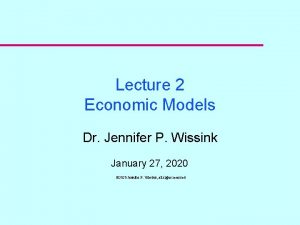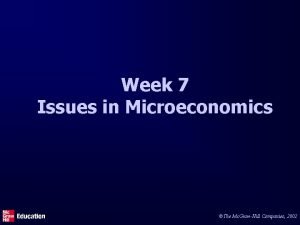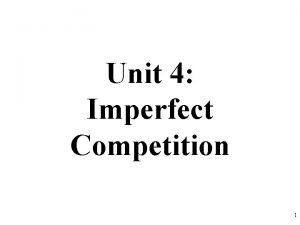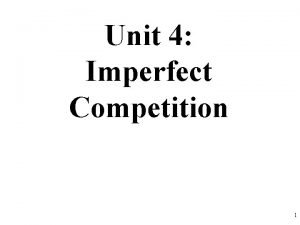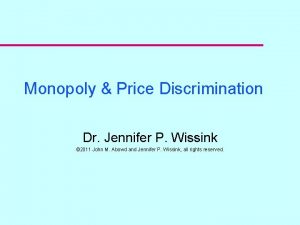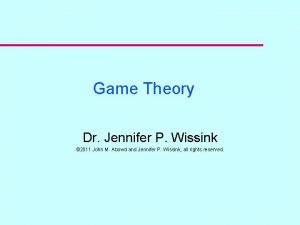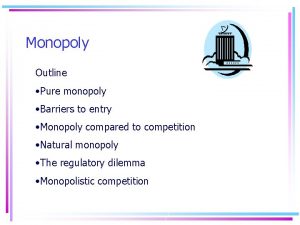Monopoly Performance Dr Jennifer P Wissink 2011 John












- Slides: 12

Monopoly Performance Dr. Jennifer P. Wissink © 2011 John M. Abowd and Jennifer P. Wissink, all rights reserved.

Graphical Display Of Simple Monopolist’s Long Run Profit Maximizing Solution u (1) The monopolist sets marginal revenue equal to marginal cost. – Then goes up to the demand curve to get the price. u u $ lrmc Psm (2) Then makes sure he is at a max (and not a min). (3) Then makes sure it is worth operating in the long run. Demand Marginal Revenue Qsm Q

Long Run Performance Measures u What would Zeus want if he were an omnipotent benevolent all knowing social planner? u Efficiency: – Pareto/Allocative Efficiency » An allocation, QPE is Pareto Efficient if no participant in the market can be made better off (feasibly) without making at least one other participant worse off. » That is, at QPE net social surplus (NSS) in the market is maximized. » NSS = $TBsociety - $TVCsociety » When NSS is maximized, $MBsociety = $MCsociety – Productive Efficiency » Each firm operates at, at least, minimum efficient scale. » Each firm operates at the minimum of its long run average total cost curve, or qpe ≥ qmes. u Equity: Is the allocation fair? Equitable? Just? – Good question that we do not answer here and now.

Simple Monopoly Performance u The simple monopoly equilibrium is NOT allocatively (Pareto) efficient. u At QSM, $MBsoc > $MCsoc u Proof: Recall that at QSM, $MR=$MC (via profit maximization). $ lrmc=$MCsociety Psm Recall that $PSM>$MR at all Q. So, $PSM > $MC at QSM. Demand=$MBsociety Now, since $P = $MBsoc all along the market demand curve, then at QSM, $MBsoc >$MCsoc. u “Dead-Weight-Loss” = [$NSS at Pareto efficient solution] – [$NSS at simple monopoly solution]. u The simple monopolist may or may not be productively efficient. – In this picture Qmes is greater than Qsm. Marginal Revenue Qsm Qpe Qmes Q

Simple Monopoly Versus Perfect Competition u u u Suppose our monopoly is owned by Daniel Grump. Dan has 25 plants scattered across the east cost. So his marginal cost curve is the efficient horizontal sum of all these. Note, this implies that Dan’s output is divided so that the marginal cost of the last unit produced in each facility is the same. Suppose one day the federal courts rule that Grump’s monopoly must be broken up. So overnight we go from monopoly to perfect competition with 25 different independent perfectly competitive firms. Suppose nothing changes in the nature of the cost structures once the monopoly is split up. – If this is the case, then the monopoly marginal cost curve can now be seen as the short run market supply curve of the perfectly competitive market. – Note: The advantage to having a monopoly in this story is that is allows the monopolist to totally control the number of units that get put on the market for sale. Under conditions of perfect competition (once the monopoly is split up) no one has any individual market power anymore, so they all act as 25 independent price taking firms. u Let’s compare the before and after.

Simple Monopoly Versus Perfect Competition P. C. S. M.

Simple Monopoly Versus Perfect Competition u u The dead weight loss from monopoly is the area BAF. Here’s another way to look at it. – – – u Consumers’ surplus lost due to monopoly = area Ppc. Psm. AFH Producers’ surplus gained due to monopoly = area Ppc. Psm. AH Producers’ surplus given up by the monopolist = area BHF Consumers’ surplus lost but gained by the monopolist as producers’ surplus = area Ppc. Psm. AH Consumers’ surplus lost and NOT captured by the monopolist = area HAF. Sum of consumers’ surplus lost and NOT captured by the monopolist and producers’ surplus given up = area BHAF = the dead weight loss of monopoly So from an equity analysis you can mention that there is a transfer of surplus from the consumers to the monopoly, But, is that a good thing or a bad thing? – Depends who you ask!!

SO: Are Monopolies Good? Bad? u Depends. . – – – What kind of monopoly is it? From whose point of view are we asking? How did the monopoly position come about? How is the monopoly position maintained? How does the monopoly behave?

Should The Government Regulate Monopolies? u Essentially all monopolies are regulated, in some way or another. u Natural monopolies are regulated by price commissions that determine the rates the monopolies may charge. u Patent, copyright and license protections are a form of ex ante regulation: firms that follow the rules for establishing the validity of their innovations receive the protection of the patent, copyright or license. u Should the government do more? Good question.

Ways The Government Can Regulate Monopolies u How about a tax on the output of the monopolist? What would that do? u How about a subsidy on the output of the monopolist? What would that do? u How about a tax on the economic profit of the monopolist? What would that do? u How about a binding price ceiling on the monopolist? What would that do? u How about breaking up the monopoly? What would that do? u How about taking away the patent? What would that do?

Taxing A Simple Monopoly’s Output

Placing A Price Ceiling On A Simple Monopoly
 Lilac zihui zhao
Lilac zihui zhao Jennifer wissink
Jennifer wissink Jennifer wissink
Jennifer wissink Annemiek wissink
Annemiek wissink Behaviorally anchored rating scales
Behaviorally anchored rating scales Performance management vs performance appraisal
Performance management vs performance appraisal 2018 jcids manual
2018 jcids manual John kotter corporate culture and performance
John kotter corporate culture and performance Welfare loss monopoly
Welfare loss monopoly Social cost of monopoly
Social cost of monopoly Characteristics of monopoly
Characteristics of monopoly Socially efficient quantity
Socially efficient quantity Advantages of monopolistic competition
Advantages of monopolistic competition
